Nursing Assignment: Analysis of Dietary Habits and Health Outcomes
VerifiedAdded on 2022/12/15
|9
|2624
|188
Report
AI Summary
This nursing assignment presents a detailed analysis of a student's three-day food and beverage recall, comparing the dietary intake to the Australian Dietary Guidelines. The report highlights the student's eating habits, including a preference for sugary drinks, refined grains, and processed foods, while also noting a deficiency in fruit and vegetable consumption. The analysis then discusses the importance of increasing water intake, reducing processed food consumption, and incorporating more fruits and vegetables into the diet. Furthermore, the assignment explores the social determinants of health, specifically education and cultural background, and their influence on health outcomes and adherence to dietary guidelines. The student reflects on how education has improved their understanding of nutrition and how cultural sensitivity from peers and professors has aided in their understanding of the Australian Dietary Guidelines. The report concludes with recommendations for improving dietary habits and achieving better health outcomes, emphasizing the need for a balanced diet, increased water intake, and mindful eating practices.
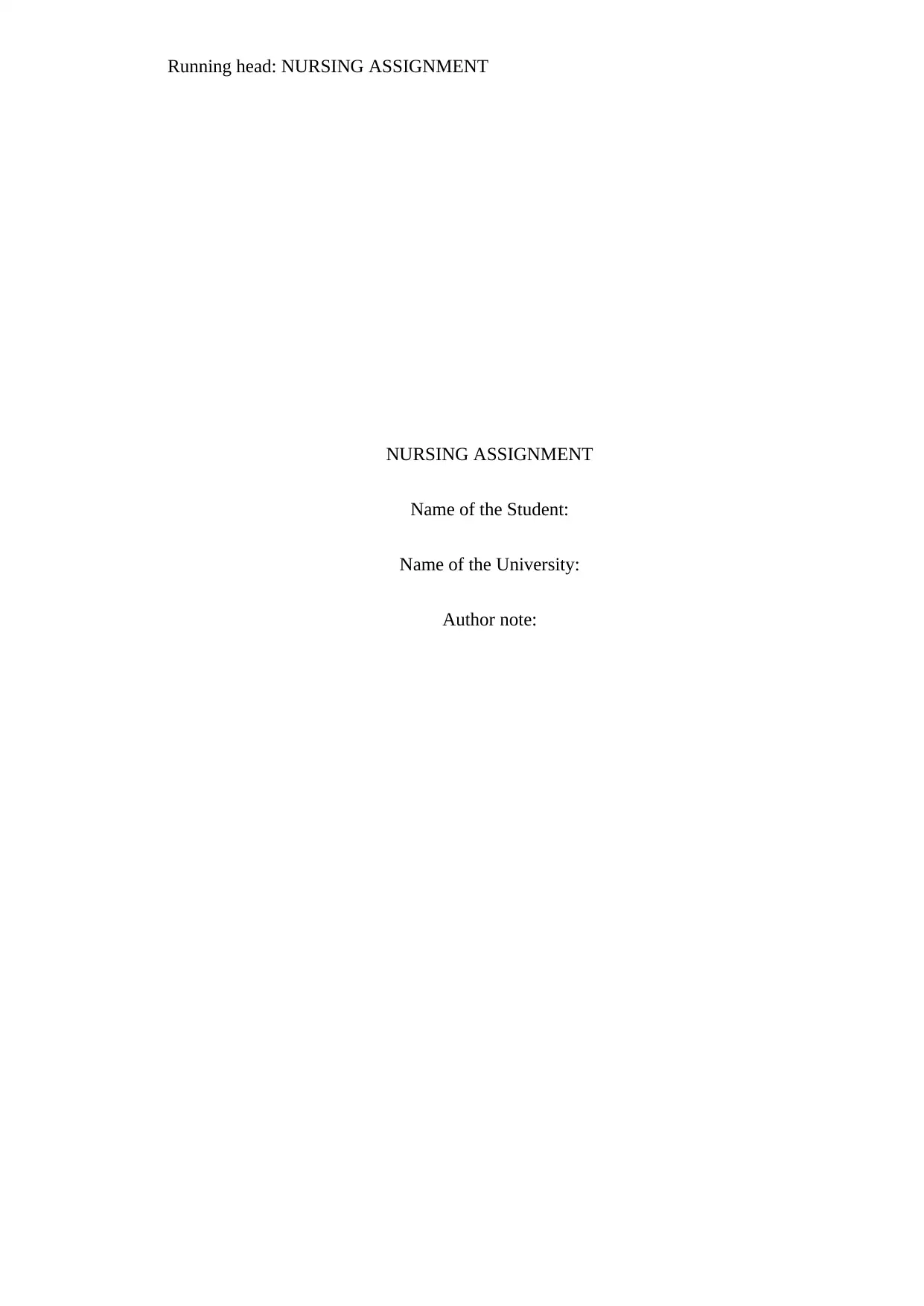
Running head: NURSING ASSIGNMENT
NURSING ASSIGNMENT
Name of the Student:
Name of the University:
Author note:
NURSING ASSIGNMENT
Name of the Student:
Name of the University:
Author note:
Paraphrase This Document
Need a fresh take? Get an instant paraphrase of this document with our AI Paraphraser
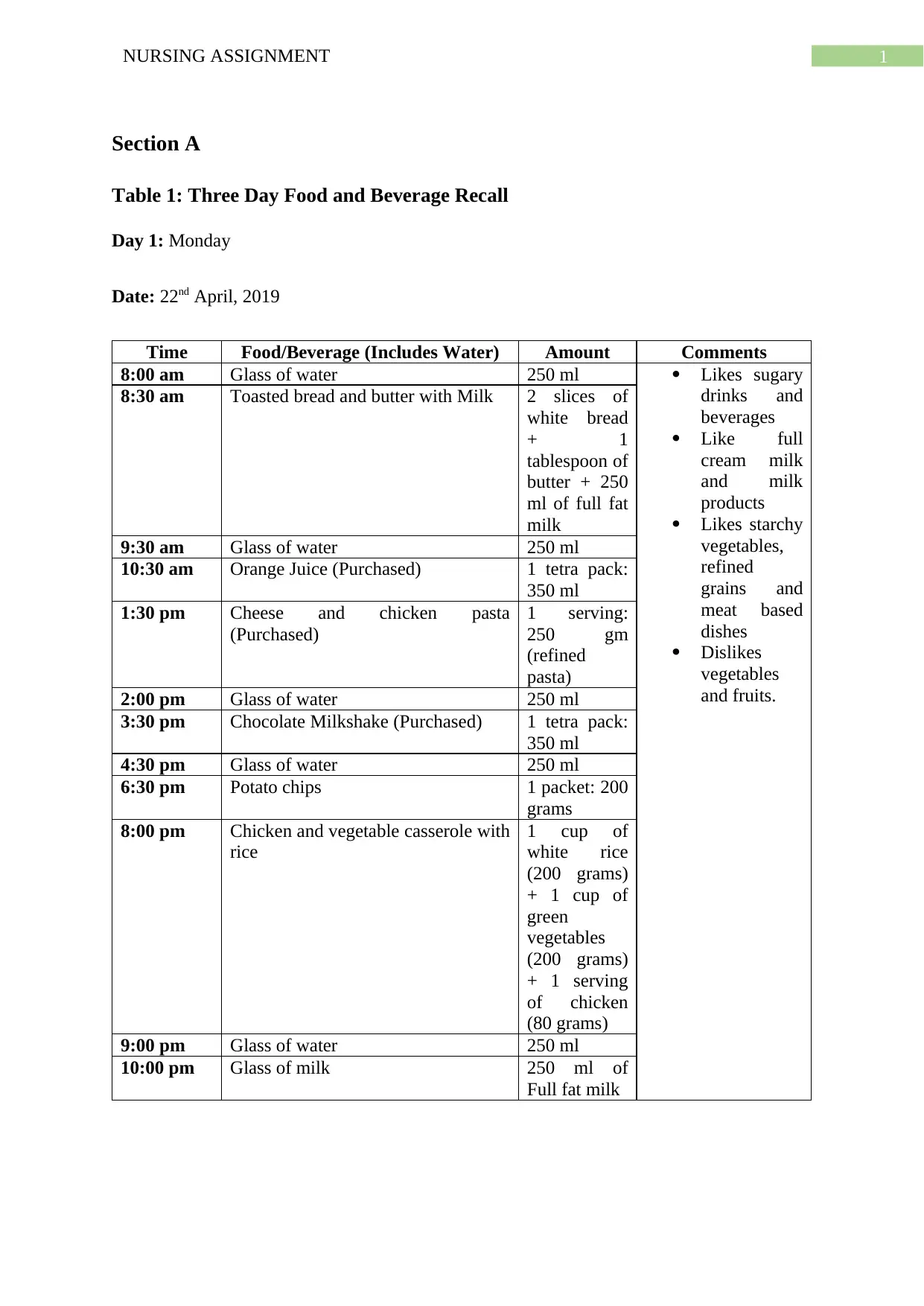
1NURSING ASSIGNMENT
Section A
Table 1: Three Day Food and Beverage Recall
Day 1: Monday
Date: 22nd April, 2019
Time Food/Beverage (Includes Water) Amount Comments
8:00 am Glass of water 250 ml Likes sugary
drinks and
beverages
Like full
cream milk
and milk
products
Likes starchy
vegetables,
refined
grains and
meat based
dishes
Dislikes
vegetables
and fruits.
8:30 am Toasted bread and butter with Milk 2 slices of
white bread
+ 1
tablespoon of
butter + 250
ml of full fat
milk
9:30 am Glass of water 250 ml
10:30 am Orange Juice (Purchased) 1 tetra pack:
350 ml
1:30 pm Cheese and chicken pasta
(Purchased)
1 serving:
250 gm
(refined
pasta)
2:00 pm Glass of water 250 ml
3:30 pm Chocolate Milkshake (Purchased) 1 tetra pack:
350 ml
4:30 pm Glass of water 250 ml
6:30 pm Potato chips 1 packet: 200
grams
8:00 pm Chicken and vegetable casserole with
rice
1 cup of
white rice
(200 grams)
+ 1 cup of
green
vegetables
(200 grams)
+ 1 serving
of chicken
(80 grams)
9:00 pm Glass of water 250 ml
10:00 pm Glass of milk 250 ml of
Full fat milk
Section A
Table 1: Three Day Food and Beverage Recall
Day 1: Monday
Date: 22nd April, 2019
Time Food/Beverage (Includes Water) Amount Comments
8:00 am Glass of water 250 ml Likes sugary
drinks and
beverages
Like full
cream milk
and milk
products
Likes starchy
vegetables,
refined
grains and
meat based
dishes
Dislikes
vegetables
and fruits.
8:30 am Toasted bread and butter with Milk 2 slices of
white bread
+ 1
tablespoon of
butter + 250
ml of full fat
milk
9:30 am Glass of water 250 ml
10:30 am Orange Juice (Purchased) 1 tetra pack:
350 ml
1:30 pm Cheese and chicken pasta
(Purchased)
1 serving:
250 gm
(refined
pasta)
2:00 pm Glass of water 250 ml
3:30 pm Chocolate Milkshake (Purchased) 1 tetra pack:
350 ml
4:30 pm Glass of water 250 ml
6:30 pm Potato chips 1 packet: 200
grams
8:00 pm Chicken and vegetable casserole with
rice
1 cup of
white rice
(200 grams)
+ 1 cup of
green
vegetables
(200 grams)
+ 1 serving
of chicken
(80 grams)
9:00 pm Glass of water 250 ml
10:00 pm Glass of milk 250 ml of
Full fat milk
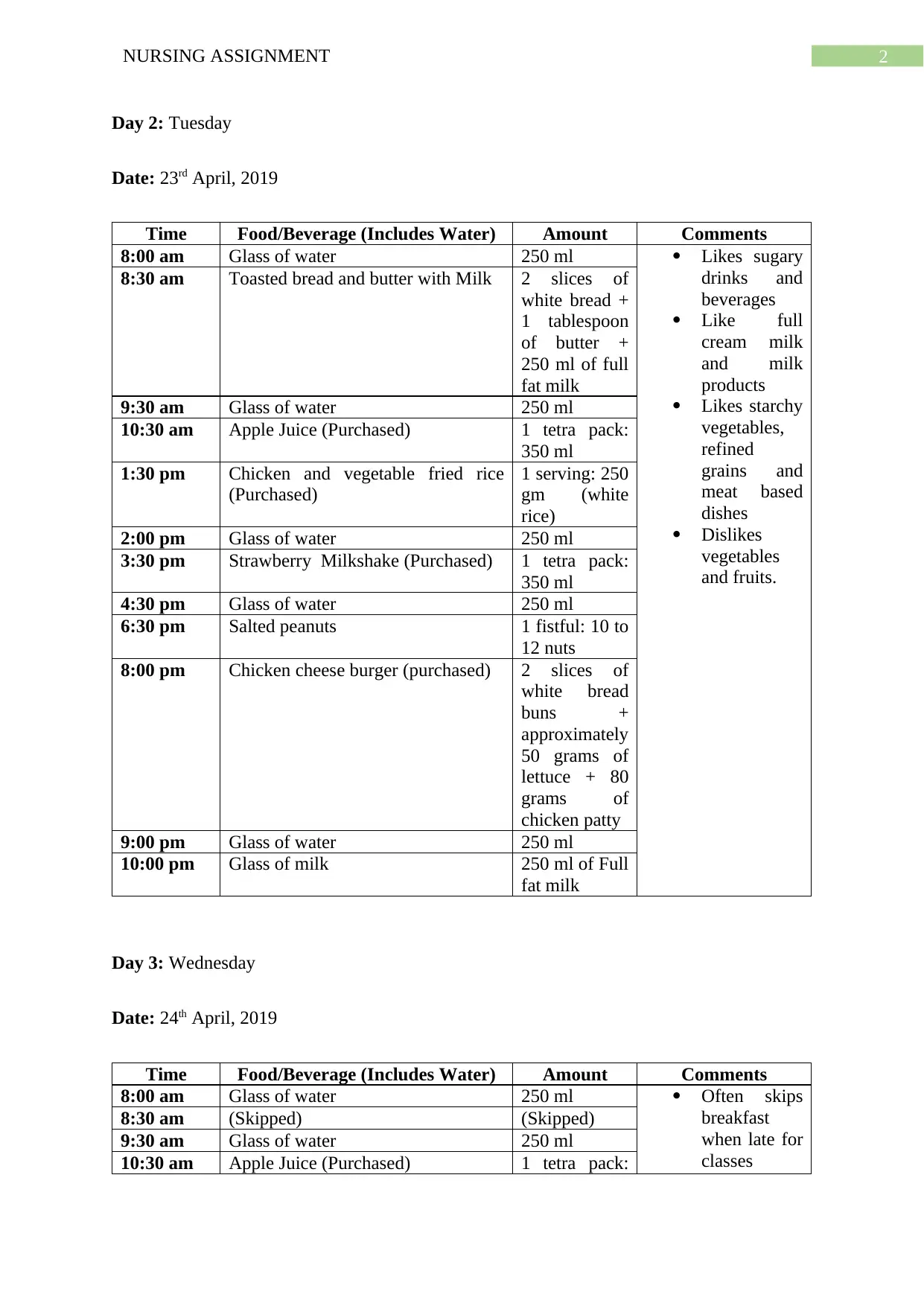
2NURSING ASSIGNMENT
Day 2: Tuesday
Date: 23rd April, 2019
Time Food/Beverage (Includes Water) Amount Comments
8:00 am Glass of water 250 ml Likes sugary
drinks and
beverages
Like full
cream milk
and milk
products
Likes starchy
vegetables,
refined
grains and
meat based
dishes
Dislikes
vegetables
and fruits.
8:30 am Toasted bread and butter with Milk 2 slices of
white bread +
1 tablespoon
of butter +
250 ml of full
fat milk
9:30 am Glass of water 250 ml
10:30 am Apple Juice (Purchased) 1 tetra pack:
350 ml
1:30 pm Chicken and vegetable fried rice
(Purchased)
1 serving: 250
gm (white
rice)
2:00 pm Glass of water 250 ml
3:30 pm Strawberry Milkshake (Purchased) 1 tetra pack:
350 ml
4:30 pm Glass of water 250 ml
6:30 pm Salted peanuts 1 fistful: 10 to
12 nuts
8:00 pm Chicken cheese burger (purchased) 2 slices of
white bread
buns +
approximately
50 grams of
lettuce + 80
grams of
chicken patty
9:00 pm Glass of water 250 ml
10:00 pm Glass of milk 250 ml of Full
fat milk
Day 3: Wednesday
Date: 24th April, 2019
Time Food/Beverage (Includes Water) Amount Comments
8:00 am Glass of water 250 ml Often skips
breakfast
when late for
classes
8:30 am (Skipped) (Skipped)
9:30 am Glass of water 250 ml
10:30 am Apple Juice (Purchased) 1 tetra pack:
Day 2: Tuesday
Date: 23rd April, 2019
Time Food/Beverage (Includes Water) Amount Comments
8:00 am Glass of water 250 ml Likes sugary
drinks and
beverages
Like full
cream milk
and milk
products
Likes starchy
vegetables,
refined
grains and
meat based
dishes
Dislikes
vegetables
and fruits.
8:30 am Toasted bread and butter with Milk 2 slices of
white bread +
1 tablespoon
of butter +
250 ml of full
fat milk
9:30 am Glass of water 250 ml
10:30 am Apple Juice (Purchased) 1 tetra pack:
350 ml
1:30 pm Chicken and vegetable fried rice
(Purchased)
1 serving: 250
gm (white
rice)
2:00 pm Glass of water 250 ml
3:30 pm Strawberry Milkshake (Purchased) 1 tetra pack:
350 ml
4:30 pm Glass of water 250 ml
6:30 pm Salted peanuts 1 fistful: 10 to
12 nuts
8:00 pm Chicken cheese burger (purchased) 2 slices of
white bread
buns +
approximately
50 grams of
lettuce + 80
grams of
chicken patty
9:00 pm Glass of water 250 ml
10:00 pm Glass of milk 250 ml of Full
fat milk
Day 3: Wednesday
Date: 24th April, 2019
Time Food/Beverage (Includes Water) Amount Comments
8:00 am Glass of water 250 ml Often skips
breakfast
when late for
classes
8:30 am (Skipped) (Skipped)
9:30 am Glass of water 250 ml
10:30 am Apple Juice (Purchased) 1 tetra pack:
⊘ This is a preview!⊘
Do you want full access?
Subscribe today to unlock all pages.

Trusted by 1+ million students worldwide
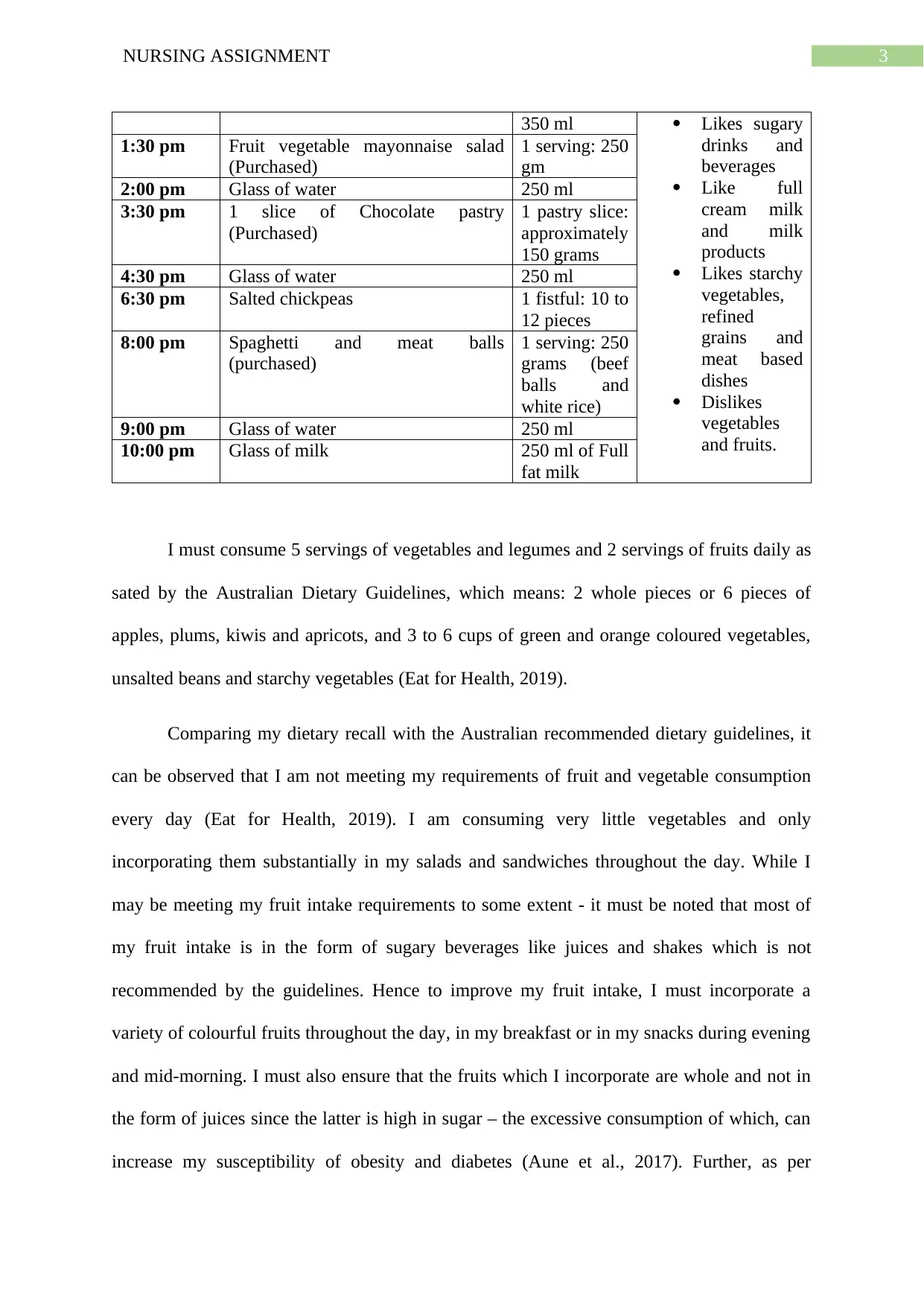
3NURSING ASSIGNMENT
350 ml Likes sugary
drinks and
beverages
Like full
cream milk
and milk
products
Likes starchy
vegetables,
refined
grains and
meat based
dishes
Dislikes
vegetables
and fruits.
1:30 pm Fruit vegetable mayonnaise salad
(Purchased)
1 serving: 250
gm
2:00 pm Glass of water 250 ml
3:30 pm 1 slice of Chocolate pastry
(Purchased)
1 pastry slice:
approximately
150 grams
4:30 pm Glass of water 250 ml
6:30 pm Salted chickpeas 1 fistful: 10 to
12 pieces
8:00 pm Spaghetti and meat balls
(purchased)
1 serving: 250
grams (beef
balls and
white rice)
9:00 pm Glass of water 250 ml
10:00 pm Glass of milk 250 ml of Full
fat milk
I must consume 5 servings of vegetables and legumes and 2 servings of fruits daily as
sated by the Australian Dietary Guidelines, which means: 2 whole pieces or 6 pieces of
apples, plums, kiwis and apricots, and 3 to 6 cups of green and orange coloured vegetables,
unsalted beans and starchy vegetables (Eat for Health, 2019).
Comparing my dietary recall with the Australian recommended dietary guidelines, it
can be observed that I am not meeting my requirements of fruit and vegetable consumption
every day (Eat for Health, 2019). I am consuming very little vegetables and only
incorporating them substantially in my salads and sandwiches throughout the day. While I
may be meeting my fruit intake requirements to some extent - it must be noted that most of
my fruit intake is in the form of sugary beverages like juices and shakes which is not
recommended by the guidelines. Hence to improve my fruit intake, I must incorporate a
variety of colourful fruits throughout the day, in my breakfast or in my snacks during evening
and mid-morning. I must also ensure that the fruits which I incorporate are whole and not in
the form of juices since the latter is high in sugar – the excessive consumption of which, can
increase my susceptibility of obesity and diabetes (Aune et al., 2017). Further, as per
350 ml Likes sugary
drinks and
beverages
Like full
cream milk
and milk
products
Likes starchy
vegetables,
refined
grains and
meat based
dishes
Dislikes
vegetables
and fruits.
1:30 pm Fruit vegetable mayonnaise salad
(Purchased)
1 serving: 250
gm
2:00 pm Glass of water 250 ml
3:30 pm 1 slice of Chocolate pastry
(Purchased)
1 pastry slice:
approximately
150 grams
4:30 pm Glass of water 250 ml
6:30 pm Salted chickpeas 1 fistful: 10 to
12 pieces
8:00 pm Spaghetti and meat balls
(purchased)
1 serving: 250
grams (beef
balls and
white rice)
9:00 pm Glass of water 250 ml
10:00 pm Glass of milk 250 ml of Full
fat milk
I must consume 5 servings of vegetables and legumes and 2 servings of fruits daily as
sated by the Australian Dietary Guidelines, which means: 2 whole pieces or 6 pieces of
apples, plums, kiwis and apricots, and 3 to 6 cups of green and orange coloured vegetables,
unsalted beans and starchy vegetables (Eat for Health, 2019).
Comparing my dietary recall with the Australian recommended dietary guidelines, it
can be observed that I am not meeting my requirements of fruit and vegetable consumption
every day (Eat for Health, 2019). I am consuming very little vegetables and only
incorporating them substantially in my salads and sandwiches throughout the day. While I
may be meeting my fruit intake requirements to some extent - it must be noted that most of
my fruit intake is in the form of sugary beverages like juices and shakes which is not
recommended by the guidelines. Hence to improve my fruit intake, I must incorporate a
variety of colourful fruits throughout the day, in my breakfast or in my snacks during evening
and mid-morning. I must also ensure that the fruits which I incorporate are whole and not in
the form of juices since the latter is high in sugar – the excessive consumption of which, can
increase my susceptibility of obesity and diabetes (Aune et al., 2017). Further, as per
Paraphrase This Document
Need a fresh take? Get an instant paraphrase of this document with our AI Paraphraser
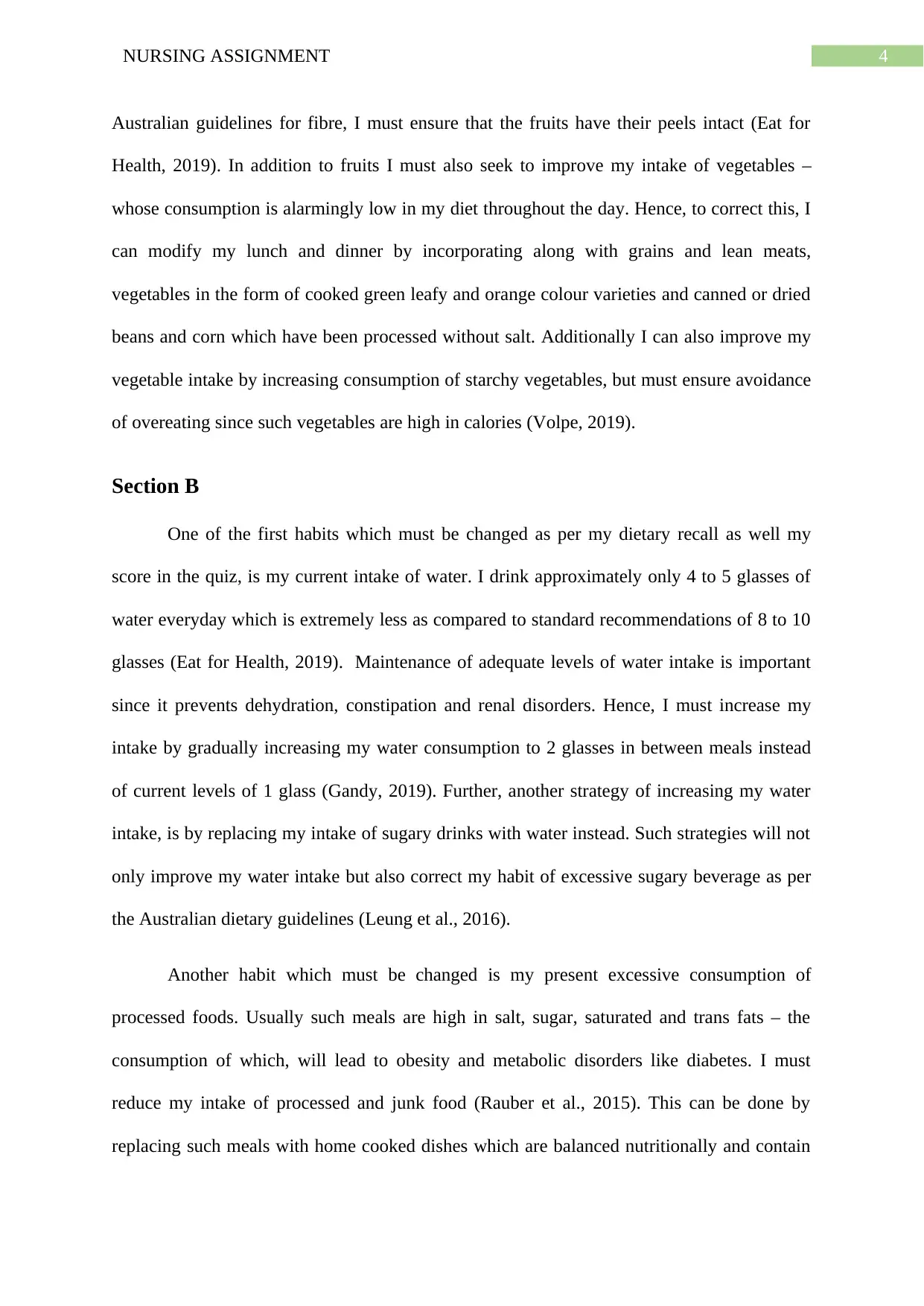
4NURSING ASSIGNMENT
Australian guidelines for fibre, I must ensure that the fruits have their peels intact (Eat for
Health, 2019). In addition to fruits I must also seek to improve my intake of vegetables –
whose consumption is alarmingly low in my diet throughout the day. Hence, to correct this, I
can modify my lunch and dinner by incorporating along with grains and lean meats,
vegetables in the form of cooked green leafy and orange colour varieties and canned or dried
beans and corn which have been processed without salt. Additionally I can also improve my
vegetable intake by increasing consumption of starchy vegetables, but must ensure avoidance
of overeating since such vegetables are high in calories (Volpe, 2019).
Section B
One of the first habits which must be changed as per my dietary recall as well my
score in the quiz, is my current intake of water. I drink approximately only 4 to 5 glasses of
water everyday which is extremely less as compared to standard recommendations of 8 to 10
glasses (Eat for Health, 2019). Maintenance of adequate levels of water intake is important
since it prevents dehydration, constipation and renal disorders. Hence, I must increase my
intake by gradually increasing my water consumption to 2 glasses in between meals instead
of current levels of 1 glass (Gandy, 2019). Further, another strategy of increasing my water
intake, is by replacing my intake of sugary drinks with water instead. Such strategies will not
only improve my water intake but also correct my habit of excessive sugary beverage as per
the Australian dietary guidelines (Leung et al., 2016).
Another habit which must be changed is my present excessive consumption of
processed foods. Usually such meals are high in salt, sugar, saturated and trans fats – the
consumption of which, will lead to obesity and metabolic disorders like diabetes. I must
reduce my intake of processed and junk food (Rauber et al., 2015). This can be done by
replacing such meals with home cooked dishes which are balanced nutritionally and contain
Australian guidelines for fibre, I must ensure that the fruits have their peels intact (Eat for
Health, 2019). In addition to fruits I must also seek to improve my intake of vegetables –
whose consumption is alarmingly low in my diet throughout the day. Hence, to correct this, I
can modify my lunch and dinner by incorporating along with grains and lean meats,
vegetables in the form of cooked green leafy and orange colour varieties and canned or dried
beans and corn which have been processed without salt. Additionally I can also improve my
vegetable intake by increasing consumption of starchy vegetables, but must ensure avoidance
of overeating since such vegetables are high in calories (Volpe, 2019).
Section B
One of the first habits which must be changed as per my dietary recall as well my
score in the quiz, is my current intake of water. I drink approximately only 4 to 5 glasses of
water everyday which is extremely less as compared to standard recommendations of 8 to 10
glasses (Eat for Health, 2019). Maintenance of adequate levels of water intake is important
since it prevents dehydration, constipation and renal disorders. Hence, I must increase my
intake by gradually increasing my water consumption to 2 glasses in between meals instead
of current levels of 1 glass (Gandy, 2019). Further, another strategy of increasing my water
intake, is by replacing my intake of sugary drinks with water instead. Such strategies will not
only improve my water intake but also correct my habit of excessive sugary beverage as per
the Australian dietary guidelines (Leung et al., 2016).
Another habit which must be changed is my present excessive consumption of
processed foods. Usually such meals are high in salt, sugar, saturated and trans fats – the
consumption of which, will lead to obesity and metabolic disorders like diabetes. I must
reduce my intake of processed and junk food (Rauber et al., 2015). This can be done by
replacing such meals with home cooked dishes which are balanced nutritionally and contain
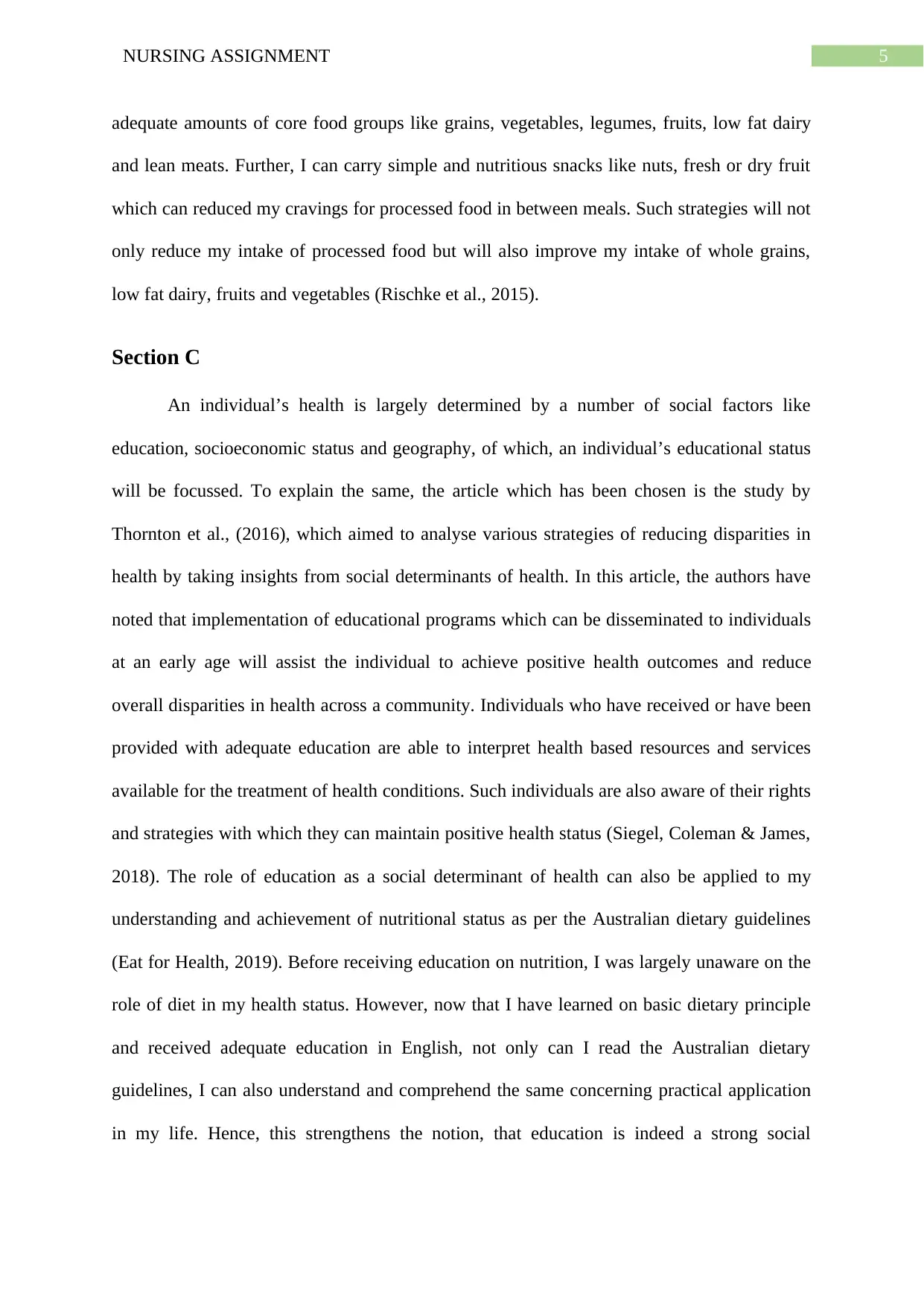
5NURSING ASSIGNMENT
adequate amounts of core food groups like grains, vegetables, legumes, fruits, low fat dairy
and lean meats. Further, I can carry simple and nutritious snacks like nuts, fresh or dry fruit
which can reduced my cravings for processed food in between meals. Such strategies will not
only reduce my intake of processed food but will also improve my intake of whole grains,
low fat dairy, fruits and vegetables (Rischke et al., 2015).
Section C
An individual’s health is largely determined by a number of social factors like
education, socioeconomic status and geography, of which, an individual’s educational status
will be focussed. To explain the same, the article which has been chosen is the study by
Thornton et al., (2016), which aimed to analyse various strategies of reducing disparities in
health by taking insights from social determinants of health. In this article, the authors have
noted that implementation of educational programs which can be disseminated to individuals
at an early age will assist the individual to achieve positive health outcomes and reduce
overall disparities in health across a community. Individuals who have received or have been
provided with adequate education are able to interpret health based resources and services
available for the treatment of health conditions. Such individuals are also aware of their rights
and strategies with which they can maintain positive health status (Siegel, Coleman & James,
2018). The role of education as a social determinant of health can also be applied to my
understanding and achievement of nutritional status as per the Australian dietary guidelines
(Eat for Health, 2019). Before receiving education on nutrition, I was largely unaware on the
role of diet in my health status. However, now that I have learned on basic dietary principle
and received adequate education in English, not only can I read the Australian dietary
guidelines, I can also understand and comprehend the same concerning practical application
in my life. Hence, this strengthens the notion, that education is indeed a strong social
adequate amounts of core food groups like grains, vegetables, legumes, fruits, low fat dairy
and lean meats. Further, I can carry simple and nutritious snacks like nuts, fresh or dry fruit
which can reduced my cravings for processed food in between meals. Such strategies will not
only reduce my intake of processed food but will also improve my intake of whole grains,
low fat dairy, fruits and vegetables (Rischke et al., 2015).
Section C
An individual’s health is largely determined by a number of social factors like
education, socioeconomic status and geography, of which, an individual’s educational status
will be focussed. To explain the same, the article which has been chosen is the study by
Thornton et al., (2016), which aimed to analyse various strategies of reducing disparities in
health by taking insights from social determinants of health. In this article, the authors have
noted that implementation of educational programs which can be disseminated to individuals
at an early age will assist the individual to achieve positive health outcomes and reduce
overall disparities in health across a community. Individuals who have received or have been
provided with adequate education are able to interpret health based resources and services
available for the treatment of health conditions. Such individuals are also aware of their rights
and strategies with which they can maintain positive health status (Siegel, Coleman & James,
2018). The role of education as a social determinant of health can also be applied to my
understanding and achievement of nutritional status as per the Australian dietary guidelines
(Eat for Health, 2019). Before receiving education on nutrition, I was largely unaware on the
role of diet in my health status. However, now that I have learned on basic dietary principle
and received adequate education in English, not only can I read the Australian dietary
guidelines, I can also understand and comprehend the same concerning practical application
in my life. Hence, this strengthens the notion, that education is indeed a strong social
⊘ This is a preview!⊘
Do you want full access?
Subscribe today to unlock all pages.

Trusted by 1+ million students worldwide
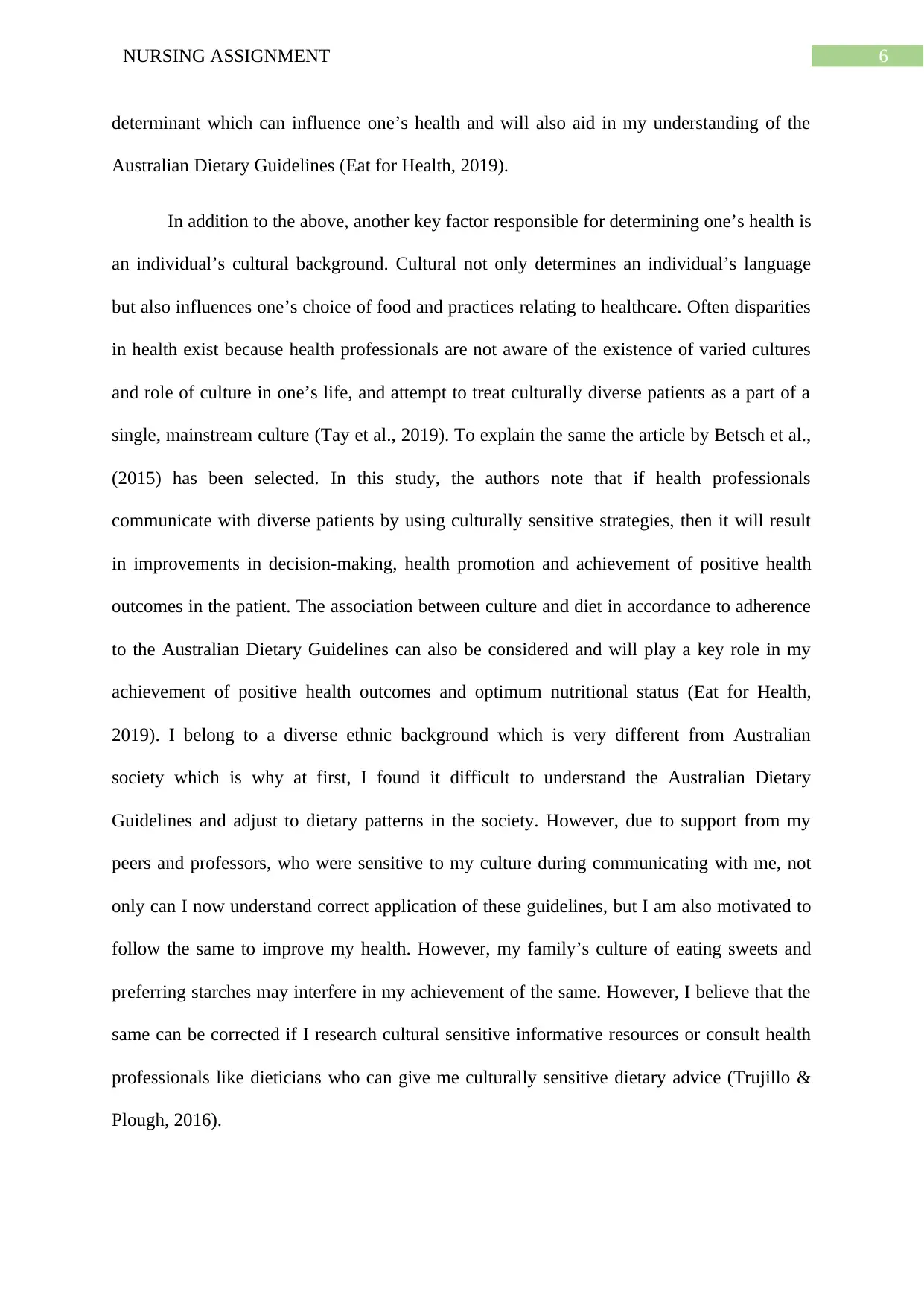
6NURSING ASSIGNMENT
determinant which can influence one’s health and will also aid in my understanding of the
Australian Dietary Guidelines (Eat for Health, 2019).
In addition to the above, another key factor responsible for determining one’s health is
an individual’s cultural background. Cultural not only determines an individual’s language
but also influences one’s choice of food and practices relating to healthcare. Often disparities
in health exist because health professionals are not aware of the existence of varied cultures
and role of culture in one’s life, and attempt to treat culturally diverse patients as a part of a
single, mainstream culture (Tay et al., 2019). To explain the same the article by Betsch et al.,
(2015) has been selected. In this study, the authors note that if health professionals
communicate with diverse patients by using culturally sensitive strategies, then it will result
in improvements in decision-making, health promotion and achievement of positive health
outcomes in the patient. The association between culture and diet in accordance to adherence
to the Australian Dietary Guidelines can also be considered and will play a key role in my
achievement of positive health outcomes and optimum nutritional status (Eat for Health,
2019). I belong to a diverse ethnic background which is very different from Australian
society which is why at first, I found it difficult to understand the Australian Dietary
Guidelines and adjust to dietary patterns in the society. However, due to support from my
peers and professors, who were sensitive to my culture during communicating with me, not
only can I now understand correct application of these guidelines, but I am also motivated to
follow the same to improve my health. However, my family’s culture of eating sweets and
preferring starches may interfere in my achievement of the same. However, I believe that the
same can be corrected if I research cultural sensitive informative resources or consult health
professionals like dieticians who can give me culturally sensitive dietary advice (Trujillo &
Plough, 2016).
determinant which can influence one’s health and will also aid in my understanding of the
Australian Dietary Guidelines (Eat for Health, 2019).
In addition to the above, another key factor responsible for determining one’s health is
an individual’s cultural background. Cultural not only determines an individual’s language
but also influences one’s choice of food and practices relating to healthcare. Often disparities
in health exist because health professionals are not aware of the existence of varied cultures
and role of culture in one’s life, and attempt to treat culturally diverse patients as a part of a
single, mainstream culture (Tay et al., 2019). To explain the same the article by Betsch et al.,
(2015) has been selected. In this study, the authors note that if health professionals
communicate with diverse patients by using culturally sensitive strategies, then it will result
in improvements in decision-making, health promotion and achievement of positive health
outcomes in the patient. The association between culture and diet in accordance to adherence
to the Australian Dietary Guidelines can also be considered and will play a key role in my
achievement of positive health outcomes and optimum nutritional status (Eat for Health,
2019). I belong to a diverse ethnic background which is very different from Australian
society which is why at first, I found it difficult to understand the Australian Dietary
Guidelines and adjust to dietary patterns in the society. However, due to support from my
peers and professors, who were sensitive to my culture during communicating with me, not
only can I now understand correct application of these guidelines, but I am also motivated to
follow the same to improve my health. However, my family’s culture of eating sweets and
preferring starches may interfere in my achievement of the same. However, I believe that the
same can be corrected if I research cultural sensitive informative resources or consult health
professionals like dieticians who can give me culturally sensitive dietary advice (Trujillo &
Plough, 2016).
Paraphrase This Document
Need a fresh take? Get an instant paraphrase of this document with our AI Paraphraser
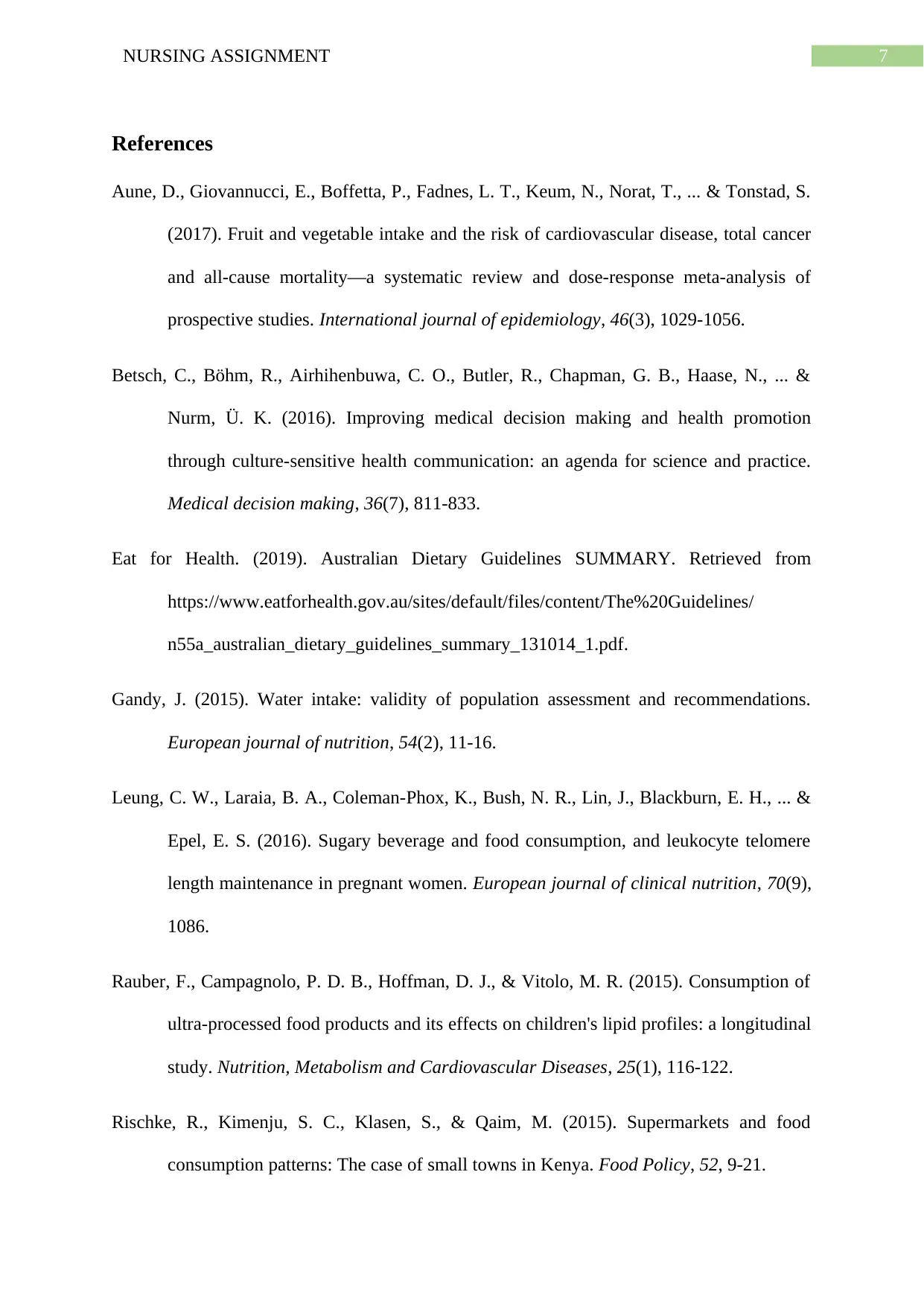
7NURSING ASSIGNMENT
References
Aune, D., Giovannucci, E., Boffetta, P., Fadnes, L. T., Keum, N., Norat, T., ... & Tonstad, S.
(2017). Fruit and vegetable intake and the risk of cardiovascular disease, total cancer
and all-cause mortality—a systematic review and dose-response meta-analysis of
prospective studies. International journal of epidemiology, 46(3), 1029-1056.
Betsch, C., Böhm, R., Airhihenbuwa, C. O., Butler, R., Chapman, G. B., Haase, N., ... &
Nurm, Ü. K. (2016). Improving medical decision making and health promotion
through culture-sensitive health communication: an agenda for science and practice.
Medical decision making, 36(7), 811-833.
Eat for Health. (2019). Australian Dietary Guidelines SUMMARY. Retrieved from
https://www.eatforhealth.gov.au/sites/default/files/content/The%20Guidelines/
n55a_australian_dietary_guidelines_summary_131014_1.pdf.
Gandy, J. (2015). Water intake: validity of population assessment and recommendations.
European journal of nutrition, 54(2), 11-16.
Leung, C. W., Laraia, B. A., Coleman-Phox, K., Bush, N. R., Lin, J., Blackburn, E. H., ... &
Epel, E. S. (2016). Sugary beverage and food consumption, and leukocyte telomere
length maintenance in pregnant women. European journal of clinical nutrition, 70(9),
1086.
Rauber, F., Campagnolo, P. D. B., Hoffman, D. J., & Vitolo, M. R. (2015). Consumption of
ultra-processed food products and its effects on children's lipid profiles: a longitudinal
study. Nutrition, Metabolism and Cardiovascular Diseases, 25(1), 116-122.
Rischke, R., Kimenju, S. C., Klasen, S., & Qaim, M. (2015). Supermarkets and food
consumption patterns: The case of small towns in Kenya. Food Policy, 52, 9-21.
References
Aune, D., Giovannucci, E., Boffetta, P., Fadnes, L. T., Keum, N., Norat, T., ... & Tonstad, S.
(2017). Fruit and vegetable intake and the risk of cardiovascular disease, total cancer
and all-cause mortality—a systematic review and dose-response meta-analysis of
prospective studies. International journal of epidemiology, 46(3), 1029-1056.
Betsch, C., Böhm, R., Airhihenbuwa, C. O., Butler, R., Chapman, G. B., Haase, N., ... &
Nurm, Ü. K. (2016). Improving medical decision making and health promotion
through culture-sensitive health communication: an agenda for science and practice.
Medical decision making, 36(7), 811-833.
Eat for Health. (2019). Australian Dietary Guidelines SUMMARY. Retrieved from
https://www.eatforhealth.gov.au/sites/default/files/content/The%20Guidelines/
n55a_australian_dietary_guidelines_summary_131014_1.pdf.
Gandy, J. (2015). Water intake: validity of population assessment and recommendations.
European journal of nutrition, 54(2), 11-16.
Leung, C. W., Laraia, B. A., Coleman-Phox, K., Bush, N. R., Lin, J., Blackburn, E. H., ... &
Epel, E. S. (2016). Sugary beverage and food consumption, and leukocyte telomere
length maintenance in pregnant women. European journal of clinical nutrition, 70(9),
1086.
Rauber, F., Campagnolo, P. D. B., Hoffman, D. J., & Vitolo, M. R. (2015). Consumption of
ultra-processed food products and its effects on children's lipid profiles: a longitudinal
study. Nutrition, Metabolism and Cardiovascular Diseases, 25(1), 116-122.
Rischke, R., Kimenju, S. C., Klasen, S., & Qaim, M. (2015). Supermarkets and food
consumption patterns: The case of small towns in Kenya. Food Policy, 52, 9-21.
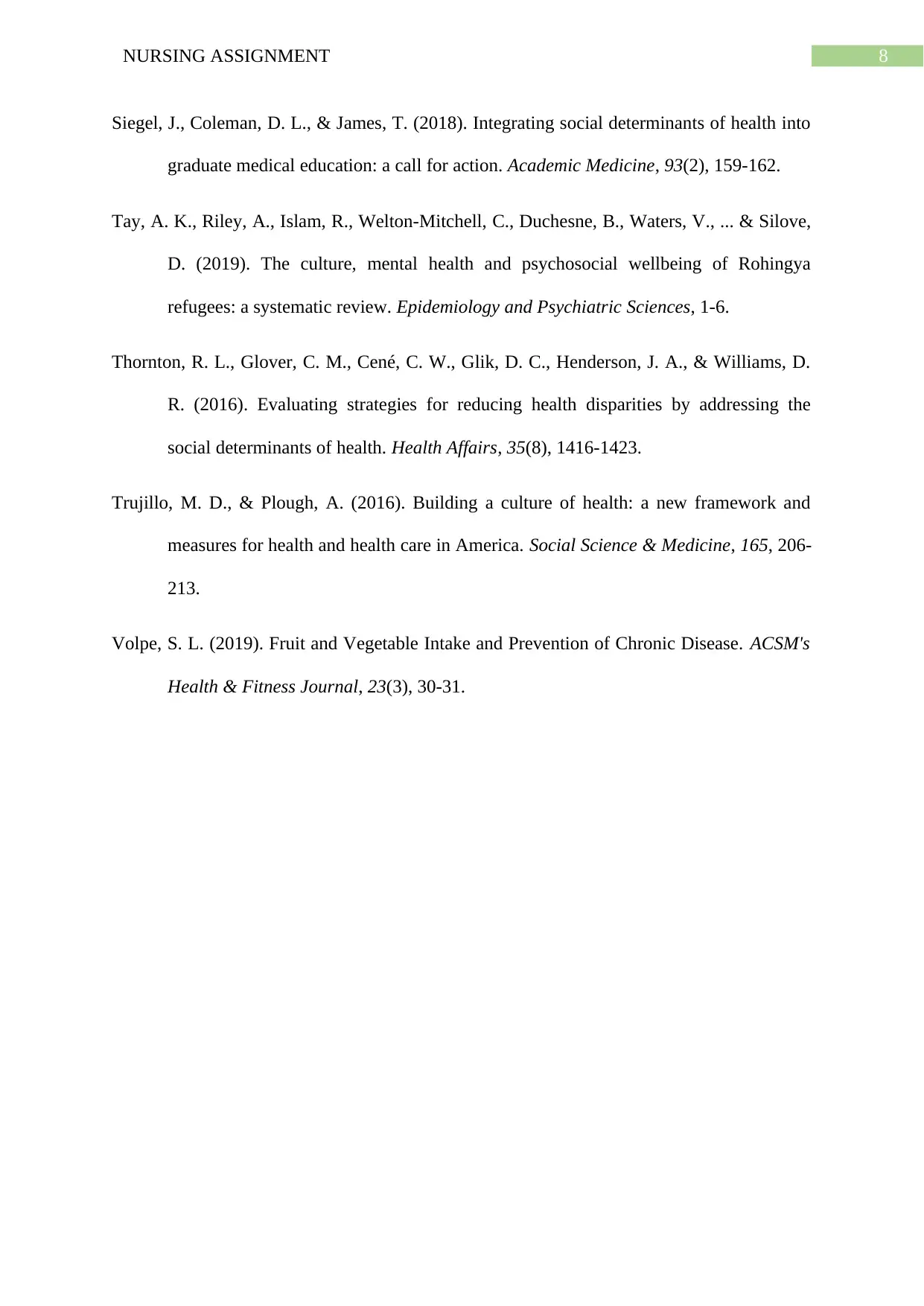
8NURSING ASSIGNMENT
Siegel, J., Coleman, D. L., & James, T. (2018). Integrating social determinants of health into
graduate medical education: a call for action. Academic Medicine, 93(2), 159-162.
Tay, A. K., Riley, A., Islam, R., Welton-Mitchell, C., Duchesne, B., Waters, V., ... & Silove,
D. (2019). The culture, mental health and psychosocial wellbeing of Rohingya
refugees: a systematic review. Epidemiology and Psychiatric Sciences, 1-6.
Thornton, R. L., Glover, C. M., Cené, C. W., Glik, D. C., Henderson, J. A., & Williams, D.
R. (2016). Evaluating strategies for reducing health disparities by addressing the
social determinants of health. Health Affairs, 35(8), 1416-1423.
Trujillo, M. D., & Plough, A. (2016). Building a culture of health: a new framework and
measures for health and health care in America. Social Science & Medicine, 165, 206-
213.
Volpe, S. L. (2019). Fruit and Vegetable Intake and Prevention of Chronic Disease. ACSM's
Health & Fitness Journal, 23(3), 30-31.
Siegel, J., Coleman, D. L., & James, T. (2018). Integrating social determinants of health into
graduate medical education: a call for action. Academic Medicine, 93(2), 159-162.
Tay, A. K., Riley, A., Islam, R., Welton-Mitchell, C., Duchesne, B., Waters, V., ... & Silove,
D. (2019). The culture, mental health and psychosocial wellbeing of Rohingya
refugees: a systematic review. Epidemiology and Psychiatric Sciences, 1-6.
Thornton, R. L., Glover, C. M., Cené, C. W., Glik, D. C., Henderson, J. A., & Williams, D.
R. (2016). Evaluating strategies for reducing health disparities by addressing the
social determinants of health. Health Affairs, 35(8), 1416-1423.
Trujillo, M. D., & Plough, A. (2016). Building a culture of health: a new framework and
measures for health and health care in America. Social Science & Medicine, 165, 206-
213.
Volpe, S. L. (2019). Fruit and Vegetable Intake and Prevention of Chronic Disease. ACSM's
Health & Fitness Journal, 23(3), 30-31.
⊘ This is a preview!⊘
Do you want full access?
Subscribe today to unlock all pages.

Trusted by 1+ million students worldwide
1 out of 9
Related Documents
Your All-in-One AI-Powered Toolkit for Academic Success.
+13062052269
info@desklib.com
Available 24*7 on WhatsApp / Email
![[object Object]](/_next/static/media/star-bottom.7253800d.svg)
Unlock your academic potential
Copyright © 2020–2025 A2Z Services. All Rights Reserved. Developed and managed by ZUCOL.




